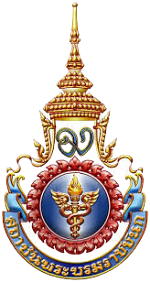ปัจจัยที่มีความสัมพันธ์ต่อความต้องการพัฒนาสมรรถนะด้านเทคโนโลยีสารสนเทศ ของเภสัชกรโรงพยาบาล เขตสุขภาพที่ 12
คำสำคัญ:
ความรู้, ทักษะ, การพัฒนาสมรรถนะ, เทคโนโลยีสารสนเทศ, เภสัชกรบทคัดย่อ
การศึกษาภาคตัดขวางครั้งนี้มีวัตถุประสงค์เพื่อศึกษาระดับความรู้ ทักษะ ความต้องการพัฒนาสมรรถนะ และปัจจัยที่มีความสัมพันธ์ต่อความต้องการพัฒนาสมรรถนะด้านเทคโนโลยีสารสนเทศ กลุ่มตัวอย่าง คือ เภสัชกรโรงพยาบาลสังกัดกระทรวงสาธารณสุข เขตสุขภาพที่ 12 จำนวน 324 คน เก็บรวบรวมข้อมูลระหว่างเดือนมีนาคม ถึง พฤษภาคม พ.ศ. 2564 โดยใช้แบบสอบถามที่ผ่านการตรวจสอบจากผู้ทรงคุณวุฒิ จำนวน 3 ท่าน มีค่าความสอดคล้องเชิงเนื้อหาอยู่ระหว่าง 0.67 - 1.00 และมีความเชื่อมั่นสัมประสิทธิ์แอลฟ่าครอนบาคเท่ากับ 0.97 วิเคราะห์ข้อมูลด้วยสถิติเชิงพรรณนา วิเคราะห์ปัจจัยที่มีความสัมพันธ์ต่อความต้องการพัฒนาสมรรถนะด้วยสถิติถดถอยโลจิสติกพหุตัวแปร
ผลการวิจัย พบว่า ค่าเฉลี่ยความรู้ด้านเทคโนโลยีสารสนเทศ (M= 2.54, S.D.= 0.84) ความรู้และทักษะด้านการจัดการสารสนเทศ (M= 2.83, S.D.= 0.77) ทักษะการใช้คอมพิวเตอร์และโปรแกรมสำเร็จรูป (M= 3.28, S.D.= 0.63) ทักษะด้านการสื่อสาร (M= 3.40, S.D.= 0.76) อยู่ในระดับปานกลาง ทักษะการใช้อินเตอร์เน็ต (M= 3.70, S.D.= 0.70) อยู่ในระดับสูง ทักษะด้านการออกแบบฐานข้อมูลอยู่ในระดับต่ำ (M= 2.32, S.D.= 0.85) และความต้องการพัฒนาสมรรถนะอยู่ในระดับปานกลาง (M= 3.64, S.D.= 0.81) และพบว่า ปัจจัยงานบริการเภสัชกรรมผู้ป่วยใน (ORadj= 1.87; 95%CI: 1.08 – 3.23) งานเภสัชกรรมคลินิก (ORadj= 2.00; 95%CI: 1.11 – 3.62) งานเภสัชกรรมปฐมภูมิ/คุ้มครองผู้บริโภค (ORadj= 0.43; 95%CI: 0.24 – 0.78)
จังหวัดที่ตั้ง (ORadj= 2.46; 95%CI: 1.01 – 6.02) ทักษะการใช้อินเตอร์เน็ต (ORadj= 0.42; 95%CI: 0.23 – 0.74) และทักษะด้านการสื่อสาร (ORadj= 4.51; 95%CI: 1.64 – 12.37) มีความสัมพันธ์ต่อความต้องการพัฒนาสมรรถนะอย่างมีนัยสำคัญทางสถิติ
ผู้บริหาร ควรสนับสนุนให้เภสัชกรที่ปฏิบัติงานบริการเภสัชกรรมผู้ป่วยใน และงานเภสัชกรรมคลินิก พัฒนาทักษะด้านการสื่อสารและทักษะการใช้อินเตอร์เน็ต เพื่อส่งเสริมให้เภสัชกรมีสมรรถนะด้านเทคโนโลยีสารสนเทศเพิ่มสูงขึ้น
เอกสารอ้างอิง
Accreditation Council for Pharmacy Education. (2011). Accreditation standards and guidelines for the professional program in pharmacy leading to the doctor of pharmacy degree. Retrieved August 14, 2020 from https://www.acpe-accredit.org/pdf/S2007Guidelines2.0_ ChangesIdentifiedInRed.pdf.
Balen, R. M., & Jewesson, P. J. (2004). Pharmacist computer skills and needs assessment survey. Journal Medical Internet Research, 6(1), e11. https://doi:10.2196/jmir.6.1.e11.
Bates, D. W. (2000). Using information technology to reduce rates of medication errors in hospitals. BMJ Clinical Research, 320(7237), 788-791. https://doi: 10.1136/bmj.320.7237.788.
Brent, I. F., Margaret, R. T., & Bill, G. F. (2010). Building core competencies in pharmacy informatics. Washington DC: American Pharmacist Association.
Chancharoen, B., Prasertchai, A., & Sitakalin, P. (2015). The relation between factors of information system management and use of administrator’s information systems among community hospitals in public health inspection Region 9. Journal of Safety and Health, 8(27), 24-30.
Chonsilapawit, T. (2015). Informatics knowledge, skills and training needs of hospital pharmacists. A thesis submitted in partial fulfillment of the requirements for the degree master of pharmacy department of health informatics graduate school, Silpakorn University, Nakhon Pathom. (in Thai)
Chouhan, V. S. & Srivastava, S. (2014). Understanding competencies and competency modeling a literature survey. Journal of Business and Management, 16(1), 14-22.
Faculty of Pharmacy Silpakorn University. (2020). Course of study faculty of pharmacy Silpakorn University. Retrieved August 5 2020, from https://www.pharmacy.su.ac.th/ Th/Admission/grad05.php. (in Thai)
Garg, A. X., Adhikari, N. K., McDonald, H., Rosas-Arellano, M. P., Devereaux, P. J., & Beyene, J., et al. (2005). Effects of computerized clinical decision support systems on practitioner performance and patient outcomes: a systematic review. JAMA, 293(10), 1223-1238. https://doi:10.1001/jama.293.10.1223.
Greiner, A. C. & Knebel, E. (2003). Health professions education: a bridge to quality. Washington (DC): National Academy Press.
Hatfield, M. D., Cox, R., Mhatre, S. K., Flowers, W. P., & Sansgiry, S. S. (2014). Impact of computerized provider order entry on pharmacist productivity. Hospital Pharmacy, 49(5), 458-465. https://doi:10.1310/hpj4905-458.
Hwang, J. I. & Park, H. A. (2011). Factors associated with nurses' informatics competency. Computers Informatics Nursing, 29(4), 256-262. https://doi:10.1097/NCN.0b013e3181fc3d24.
Institute of Medicine. (2001). Crossing the quality chasm: A new health system for the 21st century. Washington (DC): The National Academies Press.
Jungnickel, P. W., Kelley, K. W., Hammer, D. P., Haines, S. T., & Marlowe, K. F. (2009). Addressing competencies for the future in the professional curriculum. American Journal Pharmaceutical Education, 73(8), 156. https://doi:10.5688/aj7308156.
Kanoksilp, A. (2019). Smart hospital 2019. Retrieved September 20, 2020 from https://www.web2.pro.moph.go.th/evaluation/images/pdf/2563/SmartHospital_Tech Center.pdf. (in Thai)
Kleib, M. & Nagle, L. (2018). Factors associated with Canadian Nurses' informatics competency. Computers Informatics Nursing, 36(8), 406-415. https://doi:10.1097/CIN.0000000000000434.
Kwanhin, M., Jareprapat, U., & Phanthong, U. (2018). Development of nurses competencies who work in health promoting hospital in Nakhon Si Thammarat province: Research preparation. Primary Health Care Division Journal, 32(2), 1067-1082.
Mantas, J., Ammenwerth, E., Demiris, G., Hasman, A., Haux, R., & Hersh, W., et al. (2010). Recommendations of the International Medical Informatics Association (IMIA) on education in biomedical and health informatics. First Revision. Methods Information in Medicine, 49(2), 105-120. https://doi:10.3414/ME5119.
Ministry of Public Health. (2020). Health resources geographic information system 2020. Retrieved September 24, 2020 from https://www.gishealth.moph.go.th/. (in Thai)
Neri, E. D. R., Meira, A. S., Vasconcelos, H., Woods, D. J. & Fonteles, M. M. F. (2017). Knowledge, skills and attitudes of hospital pharmacists in the use of information technology and electronic tools to support clinical practice: A Brazilian survey. PLoS One, 12(12), e0189918. https://doi:10.1371/journal.pone.0189918.
Pewchaoum, S. (2009). Needs in computer training to improve effectiveness of personnel in faculty of medicine Ramathibodi hospital Mahidol University. A thesis submitted in partial fulfillment of the requirements for the degree master of education degree in adult education, Srinakharinwirot University. (in Thai)
Rahman, A. F. A., Ibrahim, M. I. M., Bahari, M. B., Haniki Nik, M. & Awang, R. (2002). Design and evaluation of the pharmacoinformatics course at a pharmacy school in Malaysia. Drug Information Journal, 36(4), 783-789.
Regional Health 12. (2020). Program to training health policy and drive operational towards sustainable health system development 2021 Public Health Region. Retrieved December 17, 2020 from https://www.rh12.moph.go.th. (in Thai)
Sukwibul, T. (2009). Considerations for creating research tools in category outcome (rating scales) for research. Retrieved Octuber 1, 2020 from https://www.ms.src.ku.ac.th/ schedule/Files/2553/Oct/1217086.doc. (in Thai)
Svensberg, K., Brandlistuen, R. E., Bjornsdottir, I., & Sporrong, S. K. (2018). Factors associated with pharmacy students' attitudes towards learning communication skills - a study among nordic pharmacy students. Research in Social and Administrative Pharmacy, 14(3), 279-289. https://doi: 10.1016/j.sapharm.2017.03.055.
The Pharmacy Council of Thailand. (2012). Joint competency of bachelor of pharmacy program, The pharmacy council of Thailand. Retrieved August 25, 2020 from https://www.pharmacycouncil.org/share/file/file_265.pdf. (in Thai)
Zhu, M., Guo, D. H., Liu, G. Y., Pei, F., Wang, B., Wang, D. X., et al. (2010). Exploration of clinical pharmacist management system and working model in China. Pharmacy World & Science, 32(4), 411-415. https://doi: 10.1007/s11096-010-9407-8.

ดาวน์โหลด
เผยแพร่แล้ว
รูปแบบการอ้างอิง
ฉบับ
ประเภทบทความ
สัญญาอนุญาต
ลิขสิทธิ์ (c) 2021 วิทยาลัยพยาบาลบรมราชชนนี นครศรีธรรมราช

อนุญาตภายใต้เงื่อนไข Creative Commons Attribution-NonCommercial-NoDerivatives 4.0 International License.
บทความที่ได้รับการตีพิมพ์เป็นลิขสิทธิ์ของ วิทยาลัยพยาบาลบรมราชชนนี นครศรีธรรมราช
ข้อความที่ปรากฏในบทความแต่ละเรื่องในวารสารวิชาการเล่มนี้เป็นความคิดเห็นส่วนตัวของผู้เขียนแต่ละท่านไม่เกี่ยวข้องกับวิทยาลัยพยาบาลบรมราชชนนี นครศรีธรรมราช และบุคคลากรท่านอื่น ๆ ในวิทยาลัยฯ แต่อย่างใด ความรับผิดชอบองค์ประกอบทั้งหมดของบทความแต่ละเรื่องเป็นของผู้เขียนแต่ละท่าน หากมีความผิดพลาดใดๆ ผู้เขียนแต่ละท่านจะรับผิดชอบบทความของตนเองแต่ผู้เดียว





